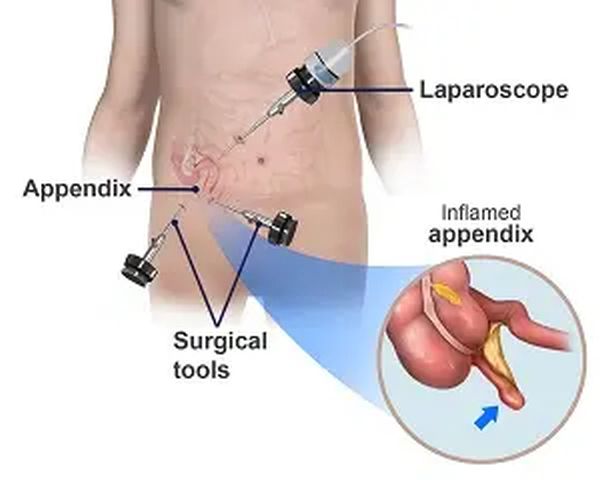+918048034294

This is your website preview.
Currently it only shows your basic business info. Start adding relevant business details such as description, images and products or services to gain your customers attention by using Boost 360 android app / iOS App / web portal.
Advancements in Laparoscopic Appendectomy: A Moder...

Advancements in Laparoscopic Appendectomy: A Modern Surgical Marvel Laparoscopic appendectomy has revolutionized the treatment of appendicitis, offering patients a minimally invasive alternative to traditional open surgery. Over the years, technological innovations and surgical refinements have significantly improved the safety, efficiency, and outcomes of this procedure. Let’s explore some of the recent advancements in laparoscopic appendectomy and how they are shaping the future of abdominal surgery. GMB ID https://maps.app.goo.gl/vpQDUk7ZjmiCJMtP7 Email dr.ankur.bhanushali@gmail.com Website https://www.drankurbhanushali.com/ 1. High-Definition and 3D Visualization One of the most significant advancements in laparoscopic appendectomy is the introduction of high-definition (HD) and 3D visualization systems. These technologies provide surgeons with clearer and more detailed images of the abdominal cavity, enhancing depth perception and precision during surgery. The result is reduced operative time and improved surgical accuracy, leading to better patient outcomes. 2. Robotic-Assisted Laparoscopic Appendectomy Robotic-assisted surgery has gained traction in various surgical fields, including appendectomy. The use of robotic systems such as the da Vinci Surgical System enhances dexterity, precision, and control for surgeons. With robotic assistance, complex cases can be handled with greater ease, reducing complications and improving recovery times for patients. 3. Single-Incision Laparoscopic Surgery (SILS) Single-incision laparoscopic surgery (SILS) is an emerging technique that involves making a single incision, typically at the navel, rather than multiple incisions. This approach offers superior cosmetic outcomes, reduced postoperative pain, and a lower risk of wound infections. SILS is gaining popularity among patients seeking minimally invasive surgical options with enhanced aesthetic results. 4. Advanced Energy Devices The development of advanced energy devices, such as ultrasonic scalpels and bipolar electrosurgical instruments, has improved hemostasis and tissue dissection in laparoscopic appendectomy. These devices minimize blood loss, reduce tissue trauma, and speed up the surgical procedure, ultimately leading to shorter hospital stays and faster patient recovery. 5. Fluorescence-Guided Surgery Fluorescence-guided surgery (FGS) is a novel technique that uses near-infrared imaging and fluorescence dyes to enhance tissue differentiation. This method allows surgeons to better visualize structures such as blood vessels and lymphatics, reducing the risk of inadvertent injury. FGS is particularly useful in complex cases where precise tissue identification is crucial. 6. Enhanced Recovery After Surgery (ERAS) Protocols Enhanced Recovery After Surgery (ERAS) protocols have been widely adopted in laparoscopic appendectomy to optimize patient outcomes. These protocols focus on preoperative optimization, multimodal pain management, early mobilization, and minimal use of drains. ERAS has been shown to reduce hospital stays, lower complication rates, and improve overall patient satisfaction. 7. Artificial Intelligence and Machine Learning Integration Artificial intelligence (AI) and machine learning (ML) are making their way into surgical practice, assisting in decision-making, risk assessment, and image-guided navigation. AI-powered systems analyze large datasets to provide real-time insights, helping surgeons make more informed choices during laparoscopic appendectomy. As AI technology evolves, its integration into surgical procedures will continue to enhance precision and efficiency. 8. Telemedicine and Remote Proctoring With advancements in telemedicine, experienced surgeons can now remotely guide less experienced colleagues during laparoscopic procedures. Remote proctoring enables real-time mentorship and training, expanding access to high-quality surgical care in remote or underserved areas. This advancement has been particularly beneficial in ensuring surgical expertise is available to a broader patient population. Conclusion The field of laparoscopic appendectomy has witnessed remarkable progress in recent years, driven by technological innovations and evolving surgical techniques. High-definition imaging, robotic assistance, single-incision approaches, and AI integration are just a few of the advancements shaping the future of this procedure. As these technologies continue to evolve, patients will benefit from safer, more efficient, and less invasive surgical interventions, ultimately improving their overall healthcare experience. Business name Dr. Ankur Bhanushali, Best Laser & Laparoscopic Surgeon, Appendix, Hernia, Gallbladder Stone, Piles Fistula Doctor in Thane Label डॉ. अंकुर भानुशाली, सर्वोत्कृष्ट लेसर आणि लॅपरोस्कोपिक सर्जन, अपेंडिक्स, हर्निया, पित्ताशयाचा खडा, पायल्स फिस्टुलासाठी , ठाणेमधील बेस्ट डॉक्टर Address 1st Floor, Aayush Multispecialty Hospital, Marigold Apt, Almeda Rd, opposite Nitin co. & Honda showroom, Namdeo Vadi, Panch Pakhdi, Thane West, Thane, Maharashtra 400602 Phone no 086910 33033

